Resistive divider when R1 = R2, split voltage in half because V = IR, and resistors in series add as Rtot = R1 + R2. It seems like this must break down as R1/2 approach 0 ohms. Anyone have a good explanation of the boundaries for when resistive divider behaves as the ideal in the equations? The wires can be assumed to be zero resistance, or, to be removed and just the resistors used for the circuit.
-
3It never goes to zero even at cryogenic temperatures for normal conductors. – Tony Stewart EE75 Nov 06 '21 at 16:45
-
I know that, I am asking about something else to understand the laws that govern resistive divider phenomena. But Lorenzo's answer seemed to answer it for me, what I missed kind of is that as R moves to 0, I moves to infinity. Why I suggested removing the wires in my question is just that I already figured out that the divider ideal breaks down when R approaches resistance of wire, but I did not think that was what I was trying to understand, so I made it explicit. – Ohm Nov 06 '21 at 17:17
-
(If you look at Lorenzo's answer, it was because I insisted in the "non real" ideal with 0 resistance wires that he answered what I did not understand. ) – Ohm Nov 06 '21 at 17:24
3 Answers
It is just a model. If you insist on assuming the wires have zero resistance, then making R1=R2 --> 0 always work, but the generator will have to source an ever increasing current (infinite current for R1=R2 -->0).
In the real world, the model breaks down when R1 and R2 approach the value of the actual wire resistance (several hundred milliohms or less, depending on the actual wire characteristics and material).
Anyway, in the real world you should also worry about the internal resistance of the generator and its current handling capability. If you lower R1 and R2 too much you will practically short the generator, with the ensuing smoke and even fire if it has no protection built in (e.g. an alkaline cell).
- 24,350
- 5
- 62
- 107
-
OK yeah I got as far as that the model breaks down when the resistors approach the resistance of the wire, since the "resistors" in series then exceed R1 and R2 by all "segments" of the wire that equate the resistors. But, then I considered the model with wires removed. And if I understand your answer, they will still continue to operate exactly as the ideal resistive divider, but the current will approach infinity as well. This makes sense, I was mostly just interested in if the resistive divider applied still but I can see that it would just that "I" component is what also moves to infinity – Ohm Nov 06 '21 at 17:15
-
@Ohm Keep in mind that any model always has limits. We use them because they are easy to work with, but as engineers/technicians we must also know when it's time to improve the model, since a model is as good as it allows us to predict the behavior of a real circuit. Extrapolating the behavior of a model to extreme conditions is a nice math exercise, but has little do do with engineering, unless you are trying to understand *when* a model stops making sense (e.g. if your model predicts that your 3V LiIon coin cell will source a 10A current, then you are waaaay out of the limits of that model). – LorenzoDonati4Ukraine-OnStrike Nov 07 '21 at 19:50
-
warning people to understand models are limited seems a bit overrated since everyone gets that. I figured out what I was wondering about, and your answer was helpful along the way. peace. – Ohm Nov 09 '21 at 20:36
-
1@Ohm "Warning people to understand models are limited seems a bit overrated since ***everyone gets that***.", Sorry, but I disagree. In my experience there are lots of people that don't understand model limitations and even the model concept. Especially newbies. Just browse this site and see how many questions have been answered by answers like "You didn't consider the model limitations..." or "The model you are using is not applicable in your situation...". – LorenzoDonati4Ukraine-OnStrike Nov 11 '21 at 08:59
-
1@Ohm Even expert people sometimes don't get them if they come from other fields. E.g. I've seen quite a few mathematicians or computer scientists having problems at first grasping how engineers think and work. They tend to need some time to switch "mental mode", especially wrt. approximations and design tradeoffs. Without knowing the level of expertise of the OP, I assume implicitly that a lack of understanding of the model may well be the cause of their problem. In my personal statistics that hit the spot several times. – LorenzoDonati4Ukraine-OnStrike Nov 11 '21 at 09:03
-
Hi Lorenzo. I understood what I asked about soon after. I think your input was really good, from a beginner point of view. I do think that warning people of this and that is overrated, society in general actually tends to underestimate every person. It does this naturally based on instincts. – Ohm Nov 11 '21 at 09:04
-
I actually think the average persons understanding of other people, is usually flawed overall. We read in a lot but most reflects ourselves, because we live in a world where people have to be put in boxes and labelled, crudely, just the way things are organized at the moment. – Ohm Nov 11 '21 at 09:05
-
I can say that I had an extreme lack of expertise when I asked the question. I resolved all that pretty soon afterwards. But, I don't think people are as dumb as we all usually tend to assume, we just live in a world where we have to suppress one another to some extent and that includes being a bit cynical, and this becomes self-fulfilling in a way based on how trust works. – Ohm Nov 11 '21 at 09:07
-
I thank you for your answer that had patience with my lack of expertise at the moment. Peace. – Ohm Nov 11 '21 at 09:07
-
(Also I understand this forums are not primarily for beginners and it is tedious with people who do not even get basic things, but as a beginner my own self-interest is to learn so I am a bit partisan to that and forced to pursue it because otherwise I will always be a beginner... ) – Ohm Nov 11 '21 at 09:11
-
@Ohm Just to avoid misunderstandings. I didn't mean to underestimate anyone or disparage anyone's knowledge. And my premises were nowhere related to your sociological analysis, on which I won't argue. Like everyone else, when deciding my course of action, I draw upon my past experiences in the context I'm currently in. It's my decades-long experience as a teacher that makes me think one of the hurdles of engineering (especially EE) is understanding models and their limitations. If the model thing wasn't the hurdle for you, good for you! :-) – LorenzoDonati4Ukraine-OnStrike Nov 11 '21 at 09:17
-
I don't think you did. I just mean I think it is a general tendency. For everyone. Everything is a compromise sort of. In some sort of ideal world, it would be different. I think your answer moved me along as a beginner and am thankful. Peace. – Ohm Nov 11 '21 at 09:22
You may be charged ;) to learn that all batteries have an effective series resistance, ESR, that may be estimated by the V and mAh capacity.
- I use a 1hour current to estimate this source resistance.
- In solid-state supplies, they often give Load Regulation specs for current with some load reg. error ratio like 1% drop at some current. This also converts to an ESR value converting %V to actual.
Load Reg. Error: Vdrop/Irated=ESR.
Using any reasonable load can be used to test and calibrate this load regulation error and measure ESR from your "voltage divider relationship”.
An AA alkaline cell with 2500mAh with 1.5V for 10h has a ratio of 1.5V/ 2.5Ah = 0.6 Ohms.
However, due to Peukert's Law you can't consume 2.5Ah in 1 minute and the capacity drops rapidly, but all batteries are by design rated for 20h (hours) capacity drain current (A*20h) and is pretty close at 1h but drops appreciably below this. Charge rates also use C ratios that show how many times more than the 1h rate it can be used at , where this by design is dependent on both the electrical low ESR and low thermal resistance to remove heat.
When you assume an ideal battery, you are assuming your R divider total resistance is at least more than the tolerance errors you are allowing.
- 1
- 3
- 54
- 182
-
if what you're saying is that battery also has resistance, ah that seems pretty common sense. so I could have specified ideal battery too, but the point of that I specified ideal wires was to get the answer Lorenzo answered, that the current approaches infinite too. but good point, R1 and R2 have to be significant resistors compared to source resistance. – Ohm Nov 07 '21 at 00:29
Anyone have a good explanation of the boundaries for when resistive divider behaves as the ideal in the equations?
Wires in the ideal world have zero resistance and no voltage drop, if a resistor has zero ohms it has no voltage drop and can be considered a wire. I will show this mathematically.
The voltage equation across a resistor looks like this:
$$ (V_1 - V_2)= I*R $$
so this is a better equation to use to find out what happens when resistance goes to zero (and since the divider equation can result from two of these equations)
$$ \lim_{R \to 0}(V_1 - V_2)= I*R \Longrightarrow(V_1 - V_2)= 0 \Longrightarrow V_1 = V_2 $$ There are two cases: the first one is if R1 goes to zero
$$ Vout = Vin(\frac{R2}{R1+R2}) $$
and you get
$$ Vout = Vin(\frac{R2}{R2}) \Longrightarrow Vout = Vin $$
which makes sense the circuit would look like this:

simulate this circuit – Schematic created using CircuitLab
the second one is if R2 goes to zero
$$ Vout = Vin(\frac{0}{R1}) \Longrightarrow Vout = 0 $$
Which also makes sense because the circuit looks like this:

And we will measure zero voltage drop because we are measuring the voltage of the same point.
- 75,799
- 36
- 80
- 208
-
1The point of the question was if both resistors approached zero. I think Lorenzo managed to see what I asked about, and answered it really well. I understand that a "resistor" that has same resistance as wire can be understood as a wire, that is pretty common sense. – Ohm Nov 07 '21 at 00:33
